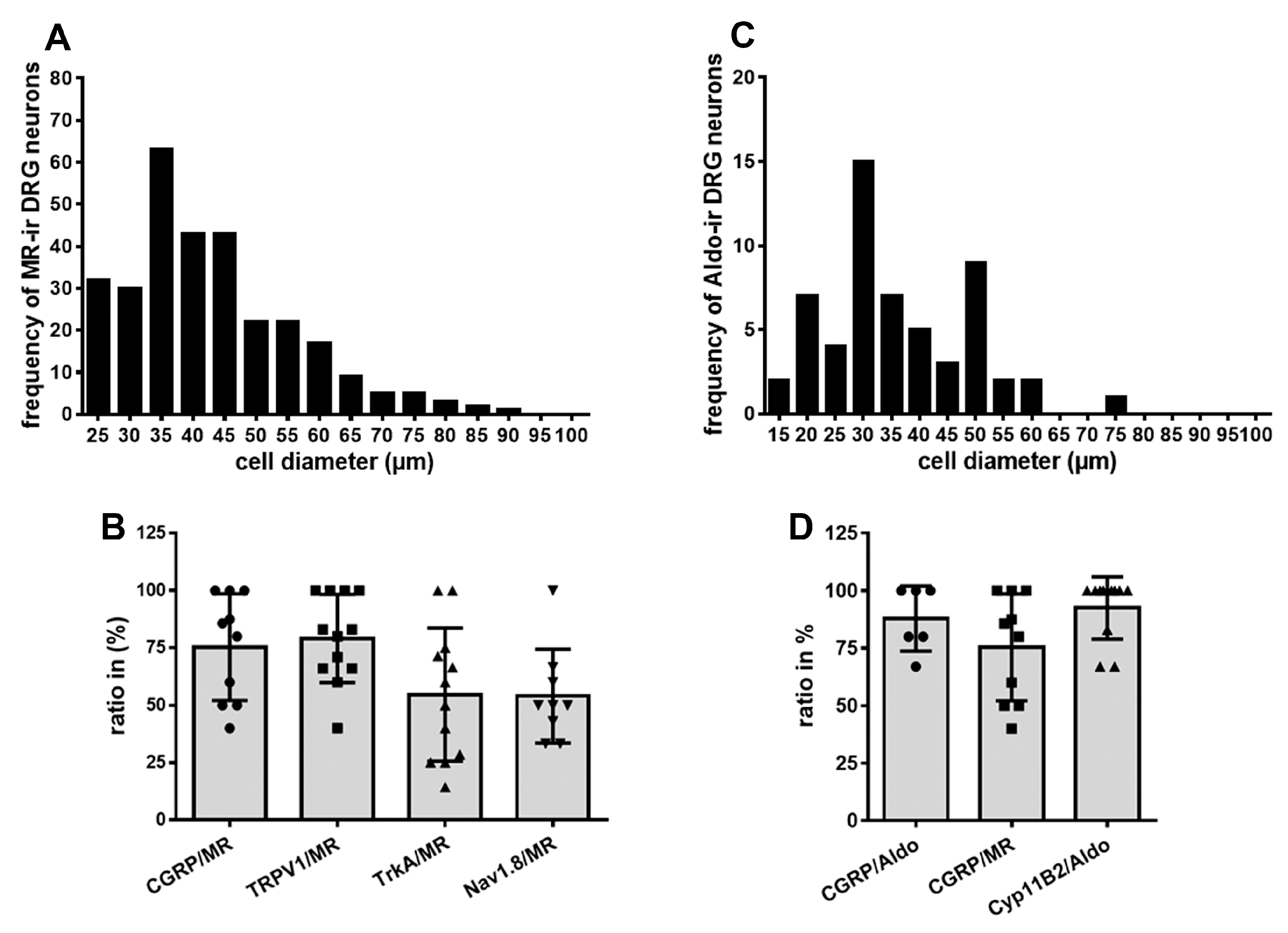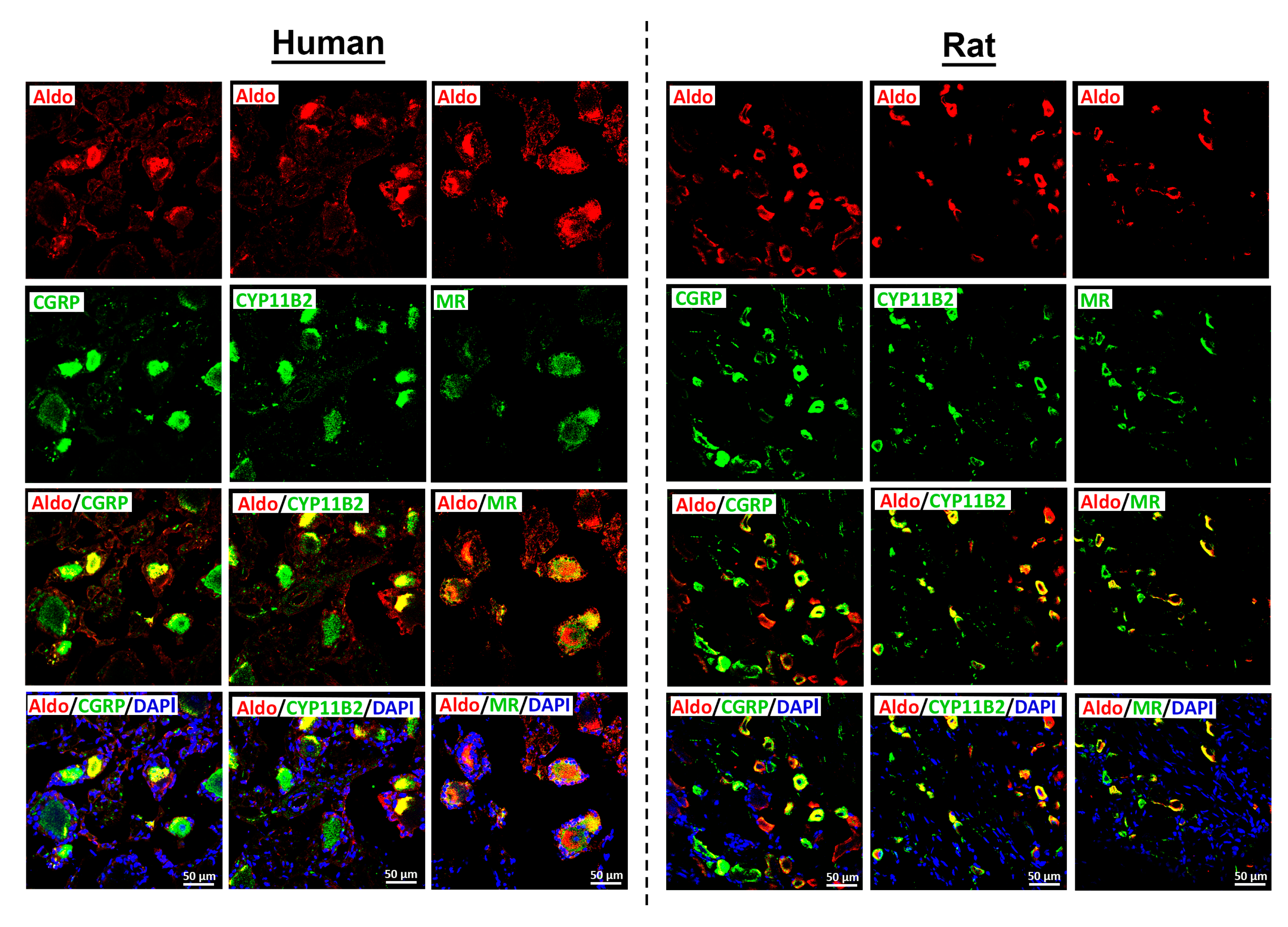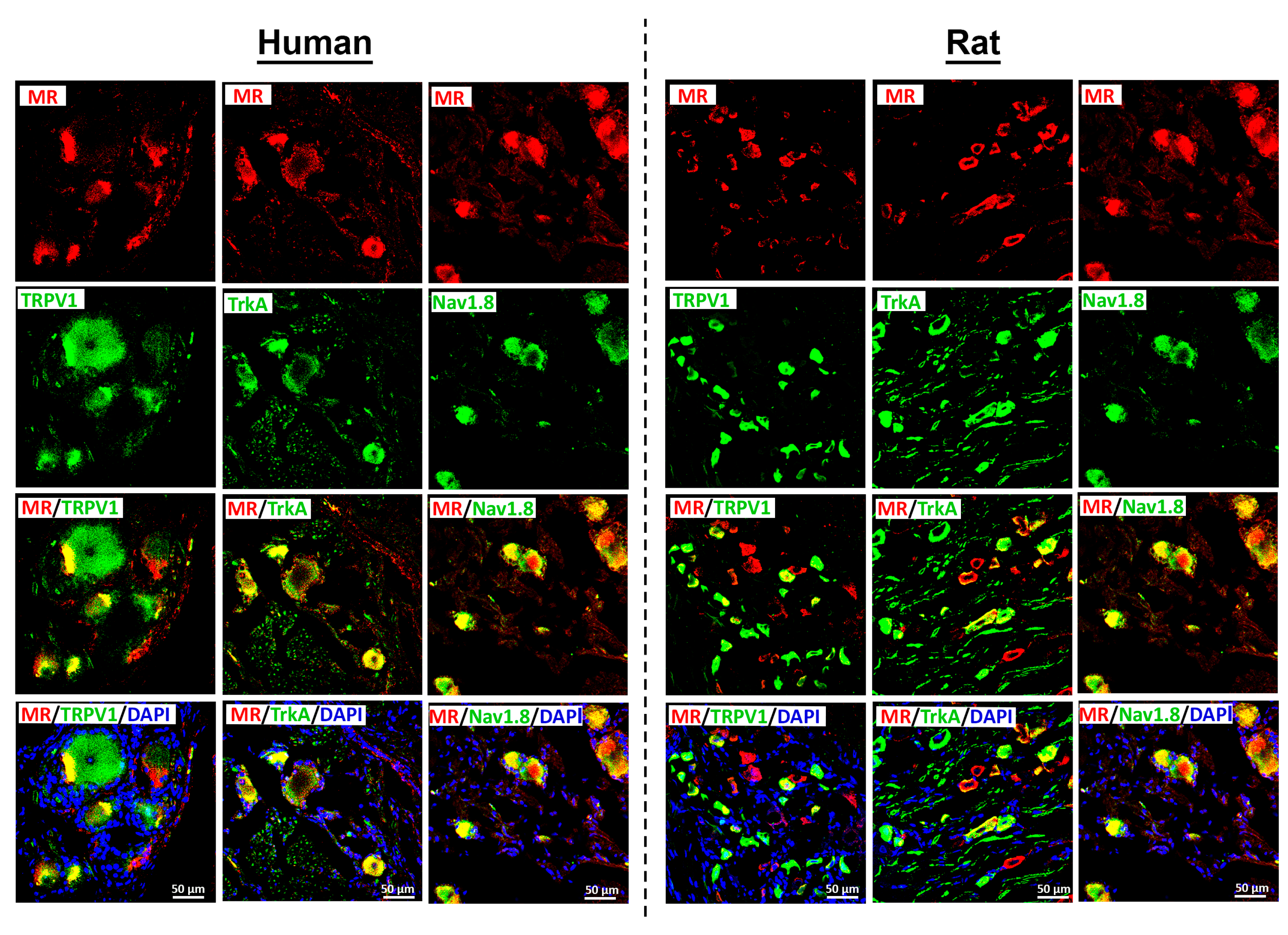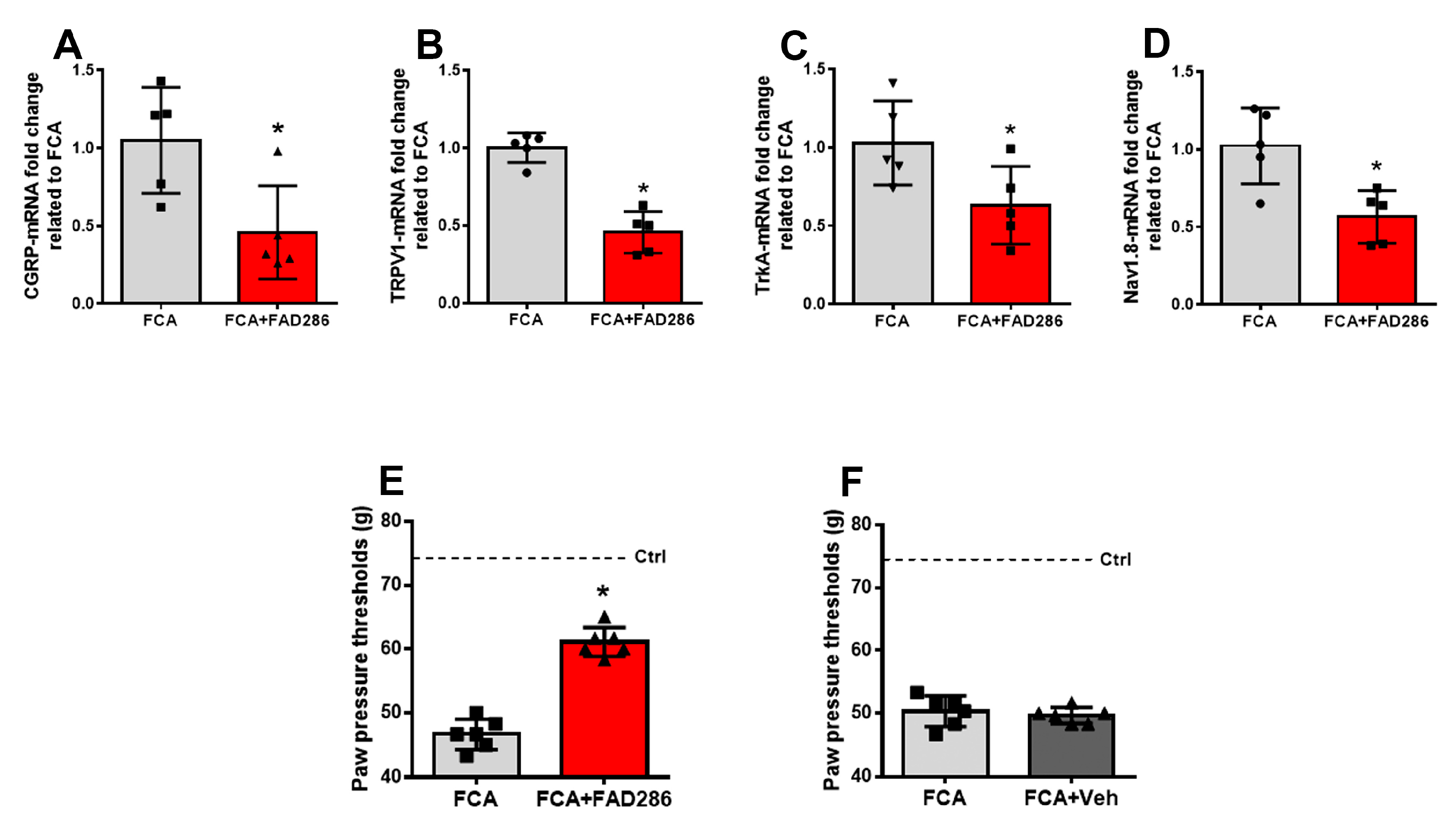Components of Mineralocorticoid Receptor System in Human DRG Neurons Co-Expressing Pain-Signaling Molecules: Implications for Nociception
Abstract
1. Introduction
2. Materials and Methods
2.1. Collection of Human and Rat DRG Tissue Samples
2.2. Experimental Animal Protocols
2.3. Quantitative RT-PCR in Human and Rat DRG
2.4. Quantification of Aldosterone in DRG
2.5. Immunohistochemistry in Human and Rat DRG
2.6. ELISA of DRG Aldosterone Content
2.7. Mechanical Hyperalgesia Testing
2.8. Statistics
3. Results
3.1. mRNA Transcript Detection of MR Together with Its Protecting Enzyme 11ß-HSD2 and Its Endogenous Ligand-Processing Enzyme CYP11B2 in Human Sensory DRG Neurons
3.2. MR Receptor Detection in CGRP-IR Sensory Neurons Colocalizing with Its Protecting Enzyme 11ß-HSD2 in Human and Rat DRG Neurons
3.3. Identification of the MR Endogenous Ligand Aldosterone with Its Processing Enzyme CYP11B2 in Human and Rat DRG Neurons
3.4. Colocalization of MR with Key Pain-Signalling Molecules in Human and Rat DRG Neurons Exhibiting a Nociceptive Phenotype
3.5. Chronic Intrathecal Inhibition of Aldosterone Synthase Prevents Both the Upregulation of Pain-Related Signaling Molecules and the Development of Mechanical Hypersensitivity During Inflammatory Pain
4. Discussion
5. Conclusions
Supplementary Materials
Author Contributions
Funding
Institutional Review Board Statement
Informed Consent Statement
Data Availability Statement
Acknowledgments
Conflicts of Interest
References
- McEwen, B.S.; Lambdin, L.T.; Rainbow, T.C.; De Nicola, A.F. Aldosterone effects on salt appetite in adrenalectomized rats. Neuroendocrinology 1986, 43, 38–43. [Google Scholar] [CrossRef] [PubMed]
- Reul, J.M.; Pearce, P.T.; Funder, J.W.; Krozowski, Z.S. Type I and type II corticosteroid receptor gene expression in the rat: Effect of adrenalectomy and dexamethasone administration. Mol. Endocrinol. 1989, 3, 1674–1680. [Google Scholar] [CrossRef] [PubMed]
- DeLeon, M.; Covenas, R.; Chadi, G.; Narvaez, J.A.; Fuxe, K.; Cintra, A. Subpopulations of primary sensory neurons show coexistence of neuropeptides and glucocorticoid receptors in the rat spinal and trigeminal ganglia. Brain Res. 1994, 636, 338–342. [Google Scholar] [CrossRef] [PubMed]
- Covenas, R.; DeLeon, M.; Chadi, G.; Cintra, A.; Gustafsson, J.A.; Narvaez, J.A.; Fuxe, K. Adrenalectomy increases the number of substance P and somatostatin immunoreactive nerve cells in the rat lumbar dorsal root ganglia. Brain Res. 1994, 640, 352–356. [Google Scholar] [CrossRef] [PubMed]
- Dong, F.; Xie, W.; Strong, J.A.; Zhang, J.M. Mineralocorticoid receptor blocker eplerenone reduces pain behaviors in vivo and decreases excitability in small-diameter sensory neurons from local inflamed dorsal root ganglia in vitro. Anesthesiology 2012, 117, 1102–1112. [Google Scholar] [CrossRef] [PubMed]
- Shaqura, M.; Li, X.; Al-Madol, M.A.; Tafelski, S.; Beyer-Koczorek, A.; Mousa, S.A.; Schafer, M. Acute mechanical sensitization of peripheral nociceptors by aldosterone through non-genomic activation of membrane bound mineralocorticoid receptors in naive rats. Neuropharmacology 2016, 107, 251–261. [Google Scholar] [CrossRef] [PubMed]
- Li, X.; Shaqura, M.; Mohamed, D.; Beyer, A.; Yamada, S.; Mousa, S.A.; Schafer, M. Pro- versus Antinociceptive Nongenomic Effects of Neuronal Mineralocorticoid versus Glucocorticoid Receptors during Rat Hind Paw Inflammation. Anesthesiology 2018, 128, 796–809. [Google Scholar] [CrossRef] [PubMed]
- Shaqura, M.; Li, L.; Mohamed, D.M.; Li, X.; Treskatsch, S.; Buhrmann, C.; Shakibaei, M.; Beyer, A.; Mousa, S.A.; Schäfer, M. Neuronal aldosterone elicits a distinct genomic response in pain signaling molecules contributing to inflammatory pain. J. Neuroinflammation 2020, 17, 183. [Google Scholar] [CrossRef] [PubMed]
- Rigel, D.F.; Fu, F.; Beil, M.; Hu, C.W.; Liang, G.; Jeng, A.Y. Pharmacodynamic and pharmacokinetic characterization of the aldosterone synthase inhibitor FAD286 in two rodent models of hyperaldosteronism: Comparison with the 11beta-hydroxylase inhibitor metyrapone. J. Pharmacol. Exp. Ther. 2010, 334, 232–243. [Google Scholar] [CrossRef] [PubMed]
- Tafelski, S.; Wandrey, J.D.; Shaqura, M.; Hong, X.; Beyer, A.; Schäfer, M.; Mousa, S.A. Translation of Experimental Findings from Animal to Human Biology: Identification of Neuronal Mineralocorticoid and Glucocorticoid Receptors in a Sectioned Main Nerve Trunk of the Leg. Cells 2023, 12, 1785. [Google Scholar] [CrossRef] [PubMed]
- Livak, K.J.; Schmittgen, T.D. Analysis of relative gene expression data using real-time quantitative PCR and the 2(-Delta Delta C(T)) Method. Methods 2001, 25, 402–408. [Google Scholar] [CrossRef] [PubMed]
- Mohamed, D.M.; Shaqura, M.; Li, X.; Shakibaei, M.; Beyer, A.; Treskatsch, S.; Schafer, M.; Mousa, S.A. Aldosterone Synthase in Peripheral Sensory Neurons Contributes to Mechanical Hypersensitivity during Local Inflammation in Rats. Anesthesiology 2020, 132, 867–880. [Google Scholar] [CrossRef] [PubMed]
- Mousa, S.A.; Shaqura, M.; Tafelski, S.; Wandrey, J.D.; Celik, Ö.; Treskatsch, S.; Schäfer, M. The Identification of Opioid Receptors and Peptide Precursors in Human DRG Neurons Expressing Pain-Signaling Molecules Confirms Their Potential as Analgesic Targets. Cells 2025, 14, 694. [Google Scholar] [CrossRef] [PubMed]
- Gomez-Sanchez, C.E.; Warden, M.; Gomez-Sanchez, M.T.; Hou, X.; Gomez-Sanchez, E.P. Diverse immunostaining patterns of mineralocorticoid receptor monoclonal antibodies. Steroids 2011, 76, 1541–1545. [Google Scholar] [CrossRef] [PubMed][Green Version]
- Gomez-Sanchez, C.E.; de Rodriguez, A.F.; Romero, D.G.; Estess, J.; Warden, M.P.; Gomez-Sanchez, M.T.; Gomez-Sanchez, E.P. Development of a panel of monoclonal antibodies against the mineralocorticoid receptor. Endocrinology 2006, 147, 1343–1348. [Google Scholar] [CrossRef] [PubMed]
- Haque, M.; Wilson, R.; Sharma, K.; Mills, N.J.; Teruyama, R. Localisation of 11β-Hydroxysteroid Dehydrogenase Type 2 in Mineralocorticoid Receptor Expressing Magnocellular Neurosecretory Neurones of the Rat Supraoptic and Paraventricular Nuclei. J. Neuroendocr. 2015, 27, 835–849. [Google Scholar] [CrossRef] [PubMed]
- Teruyama, R.; Sakuraba, M.; Wilson, L.L.; Wandrey, N.E.; Armstrong, W.E. Epithelial Na+ sodium channels in magnocellular cells of the rat supraoptic and paraventricular nuclei. Am. J. Physiol. Endocrinol. Metab. 2012, 302, E273–E285. [Google Scholar] [CrossRef] [PubMed]
- Ibarrola, J.; Lopez-Andres, N. Editorial: Heart valve diseases: From molecular mechanisms to clinical implications. Front. Mol. Med. 2023, 3, 1260912. [Google Scholar] [CrossRef] [PubMed]
- Caterina, M.J. Vanilloid receptors take a TRP beyond the sensory afferent. Pain 2003, 105, 5–9. [Google Scholar] [CrossRef] [PubMed]
- Akopian, A.N.; Souslova, V.; England, S.; Okuse, K.; Ogata, N.; Ure, J.; Smith, A.; Kerr, B.J.; McMahon, S.B.; Boyce, S.; et al. The tetrodotoxin-resistant sodium channel SNS has a specialized function in pain pathways. Nat. Neurosci. 1999, 2, 541–548. [Google Scholar] [CrossRef] [PubMed]
- McMahon, S.B.; Russa, F.L.; Bennett, D.L. Crosstalk between the nociceptive and immune systems in host defence and disease. Nat. Rev. Neurosci. 2015, 16, 389–402. [Google Scholar] [CrossRef] [PubMed]
- Edvinsson, L.; Haanes, K.A.; Warfvinge, K.; Krause, D.N. CGRP as the target of new migraine therapies—Successful translation from bench to clinic. Nat. Rev. Neurol. 2018, 14, 338–350. [Google Scholar] [CrossRef] [PubMed]
- Stein, C.; Millan, M.; Herz, A. Unilateral inflammation of the hindpaw in rats as a model of prolonged noxious stimulation: Alterations in behavior and nociceptive thresholds. Pharmacol. Biochem. Behav. 1988, 31, 445–451. [Google Scholar] [CrossRef] [PubMed]
- Qualls, K.A.; Kadakia, F.K.; Serafin, E.K.; Lückemeyer, D.N.; Davidson, S.; Strong, J.A.; Zhang, J.M. mRNA Expression of Mineralocorticoid and Glucocorticoid Receptors in Human and Mouse Sensory Neurons of the Dorsal Root Ganglia. Anesth. Analg. 2025, 140, 1216–1226. [Google Scholar] [CrossRef] [PubMed]
- Colombo, L.; Dalla Valle, L.; Fiore, C.; Armanini, D.; Belvedere, P. Aldosterone and the conquest of land. J. Endocrinol. Investig. 2006, 29, 373–379. [Google Scholar] [CrossRef] [PubMed]
- Nieckarz, A.; Graff, B.; Burnier, M.; Marcinkowska, A.B.; Narkiewicz, K. Aldosterone in the brain and cognition: Knowns and unknowns. Front. Endocrinol. 2024, 15, 1456211. [Google Scholar] [CrossRef] [PubMed]
- Gomez-Sanchez, C.E.; Qi, X.; Velarde-Miranda, C.; Plonczynski, M.W.; Parker, C.R.; Rainey, W.; Satoh, F.; Maekawa, T.; Nakamura, Y.; Sasano, H.; et al. Development of monoclonal antibodies against human CYP11B1 and CYP11B2. Mol. Cell. Endocrinol. 2014, 383, 111–117. [Google Scholar] [CrossRef] [PubMed]
- Méndez-Reséndiz, K.A.; Enciso-Pablo, Ó.; González-Ramírez, R.; Juárez-Contreras, R.; Rosenbaum, T.; Morales-Lázaro, S.L. Steroids and TRP Channels: A Close Relationship. Int. J. Mol. Sci. 2020, 21, 3819. [Google Scholar] [CrossRef] [PubMed]
- Gangula, P.R.; Lanlua, P.; Wimalawansa, S.; Supowit, S.; DiPette, D.; Yallampalli, C. Regulation of calcitonin gene-related peptide expression in dorsal root ganglia of rats by female sex steroid hormones. Biol. Reprod. 2000, 62, 1033–1039. [Google Scholar] [CrossRef] [PubMed]
- Scott, J.H.; Menouar, M.A.; Dunn, R.J. Physiology, Aldosterone. In StatPearls; StatPearls Publishing LLC.: Orlando, FL, USA, 2025. [Google Scholar]






Disclaimer/Publisher’s Note: The statements, opinions and data contained in all publications are solely those of the individual author(s) and contributor(s) and not of MDPI and/or the editor(s). MDPI and/or the editor(s) disclaim responsibility for any injury to people or property resulting from any ideas, methods, instructions or products referred to in the content. |
© 2025 by the authors. Licensee MDPI, Basel, Switzerland. This article is an open access article distributed under the terms and conditions of the Creative Commons Attribution (CC BY) license (https://creativecommons.org/licenses/by/4.0/).
Share and Cite
Mousa, S.A.; Hong, X.; Metwally, E.Y.; Tafelski, S.; Wandrey, J.D.; Piontek, J.; Treskatsch, S.; Schäfer, M.; Shaqura, M. Components of Mineralocorticoid Receptor System in Human DRG Neurons Co-Expressing Pain-Signaling Molecules: Implications for Nociception. Cells 2025, 14, 1142. https://doi.org/10.3390/cells14151142
Mousa SA, Hong X, Metwally EY, Tafelski S, Wandrey JD, Piontek J, Treskatsch S, Schäfer M, Shaqura M. Components of Mineralocorticoid Receptor System in Human DRG Neurons Co-Expressing Pain-Signaling Molecules: Implications for Nociception. Cells. 2025; 14(15):1142. https://doi.org/10.3390/cells14151142
Chicago/Turabian StyleMousa, Shaaban A., Xueqi Hong, Elsayed Y. Metwally, Sascha Tafelski, Jan David Wandrey, Jörg Piontek, Sascha Treskatsch, Michael Schäfer, and Mohammed Shaqura. 2025. "Components of Mineralocorticoid Receptor System in Human DRG Neurons Co-Expressing Pain-Signaling Molecules: Implications for Nociception" Cells 14, no. 15: 1142. https://doi.org/10.3390/cells14151142
APA StyleMousa, S. A., Hong, X., Metwally, E. Y., Tafelski, S., Wandrey, J. D., Piontek, J., Treskatsch, S., Schäfer, M., & Shaqura, M. (2025). Components of Mineralocorticoid Receptor System in Human DRG Neurons Co-Expressing Pain-Signaling Molecules: Implications for Nociception. Cells, 14(15), 1142. https://doi.org/10.3390/cells14151142








